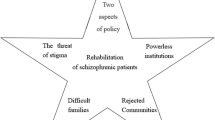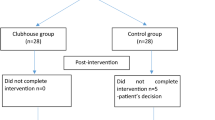Abstract
Chronic social disablement is caused by three types of factor: impairment, e.g. slowness in schizophrenia; social disadvantage, e.g. lack of opportunity to develop social or vocational skills; and an underconfidence or unduly low self-esteem which is reactive to impairment and disadvantage. The last of these factors is particularly evident in ‘institutionalism’, a condition in which the individual comes to acquire a contentment with institutional life and wishes to lead no other. Many long-stay patients in large mental hospitals used to be ‘well-institutionalized’ but it became recognized that retraining and rehabilitation could lead to successful resettlement outside hospital. For a time these striking successes suggested to some theorists that abolishing the hospitals would abolish disablement as well but it is now quite clear that this is not the case. Chronic impairments still occur and create a continuing need for sheltered environments. The frequency and type of problems still arising are discussed in the light of recent surveys in England. One small group requires highly-staffed accommodation, others need less supervised day and residential settings; all need long-term care. It is emphasized that some people living at home with relatives also have chronic mental disabilities as have a high proportion of the destitute. Such problems are less frequent than formerly but they still require detailed medical and social attention.
Similar content being viewed by others
References
Kramer M:Psychiatric Services and the Changing Insitutional Scne, 1950–1985. DHEW Publication No. (ADM) 77-433. Washington, U.S. Government Printing Office, 1977.
Babigian HM: Schizophrenia: Epidemiology. In Freedman AM, Kaplan HI, Sadork BO (eds):Comprehensive Textbook of Psychiatry, Vol. II. Baltimore, Williams & Wilkins, 1975.
Cooper JC, Kendell RE, Gurland BJ, Sharpe L, Copeland JRM, Simon, R:Psychiatric Diagnosis in New York and London. London: Oxford University Press, 1972.
World Health Organization:The International Pilot Study of Schizophrenia. Geneva, WHO, 1973.
Wing JK, Cooper JE, Sartorius, N:The Description and Classification of Psychiatric Symptoms: An Instruction Manual for the PSE and Catego System. London, Cambridge University Press, 1974.
Belknap I:Human Problems of a State Mental Hospital. New York, McGraw Hill, 1956.
Dunham HW, Weinberg, SK:Culture of the State Mental Hospital. Detroit, Wayne State University Press, 1960.
Goffman E: (1961) On the characteristics of total institutions. In Cressey DR (ed):The Prison. New York, Holt, Rinehart and Winston, 1961.
Cumming J, Cumming E: The locus of power in a large mental hospital.Psychiatry 19: 361, 1950.
Jones K:A History of the Mental Health Services. London, Routledge, 1972.
Rothman DJ:The Discovery of the Asylum: Social Order and Disorder in the New Republic. Boston, Little, Brown and Company, 1971.
Wing JK: Institutionalism in mental hospitals.Br J Soc Clin Psychol 1: 38, 1962.
Wing JK, Brown, GW:Institutionalism and Schizophrenia. London: Cambridge University Press, 1970.
Macmillan D: Hospital-community relationships. InProceedings of the Thirty-Fourth Annual Conference of the Milbank Memorial Fund. New York, Milbank, 1957.
Bockoven JS: Moral treatment in American psychiatry.J. Nerv Ment Dis 124: 167–194, 292–321, 1956.
Rees TP: Back to moral treatment.J Ment Sci 103: 303, 1957.
Main TF: The hospital as a therapeutic institution.Bull Menninger Clinic 10: 66–70, 1946.
Jones M:Social Psychiatry in the Community, in Hospitals, and in Prisons. Springfield, Ill., Charles C. Thomas, 1962.
Fairweather GW, Sanders DH, Cresslee DL, Maynard H:Community Life for the Mentally Ill. Chicago, Aldine Publishing Co., 1969.
Gruenberg EM, Huxley A (eds):Evaluating the Effectiveness of Community Mental Health Services. New York, Milbank Memorial Fund, 1960.
Wing JK: A pilot experiment on the rehabilitation of long-hospitalized male schizophrenic patients.Br J Prev Soc Med 14: 173, 1960.
Wing JK, Bennett DH, Denham J:The Industrial Rehabilitation of Long-stay schizophrenic patients. Med. Res. Council Memo. No. 42. London, HMSO, 1964.
Catterson A, Bennett DH, Freudenberg RK: A survey of longstay schizophrenic patients.Br J Psychiat 109: 750, 1963.
Wing JK, Freudenberg RK: The response of severely ill chronic schizophrenic patients to social stimulation.Am J Psychiat 118: 311, 1961.
Brill H, Patton RE: Clinical statistical analysis of population changes in New York State Mental Hospitals since introduction of psychotropic drugs.Am J Psychiat 119: 20, 1962.
Tooth G, Brooke EM: Trends in the mental hospital population and their effect on future planning.Lancet 1: 710–713, 1961.
Godber C: Reason for the increase in admissions. In Wing JK, Hailey AM (eds):Evaluating a Community Psychiatric Service. London, Oxford University Press, 1972.
Wing JK, Hailey AM (eds):Evaluating a Community Psychiatric Service: The Camberwell Register 1964–1971. London, Oxford University Press, 1972.
Wing JK, Fryers T:Psychiatric Services in Camberwell and Salford. London, MRC Social Psychiatry Unit, Institute of Psychiatry, 1976.
Bauer M:Sektorisierte Psychiatrie. Stuttgart, Enke Verlag, 1977.
Pollack ES, Taube CA: Trends and projections in state hospital use. In Zusman J, Bertsch EF (eds):The Future Role of the State Hospital. Lexington, Mass., Lexington Books, 1975.
Mendel WM: Lepers, madman—who's next?Schizophrenia Bull 11:5–8, 1974.
Rieder RO: Hospitals, patients and politics.Schizophrenia Bull 11: 9–15, 1974.
Department of Health and Social Security:In-patient statistics from the Mental Health Enquiry for the year 1971. Stat. and Res. Rep. Series No. 6. London, HMSO, 1973.
Mann S, Sproule J: Reasons for a six months stay. In Wing JK, Hailey AM (eds):Evaluating a Community Psychiatric Service. London: Oxford University Press, 1972.
Mann S, Cree W: ‘New’ long-stay psychiatric patients: A national sample of 15 mental hospitals in England and Wales, 1972–3.Psychol Med 6: 603–616, 1976.
Department of Health and Social Security: Better Services for the Mentally Ill. Cmnd. 6233. London, HMSO, 1975.
Brown GW, Bone M, Dalison B, Wing JK:Schizophrenia and Social Care. London, Oxford University Press, 1966.
Sartorius N, Jablensky A, Shapiro R: Two-year follow-up of the patients included in the WHO International Pilot Study of Schizophrenia.Psychol Med 7: 529–542, 1977.
Hewett S, Ryan P, Wing JK: Living without the mental hospitals.J Soc Policy 4: 391–404, 1975.
Ryan P, Hewett SH, A pilot study of hostels for the mentally ill.Soc. Work Today 6: 25, 774-778, 1976.
Black BS: Occupational rehabilitation, day centers, and workshops.Psychiat Q 48: 549–557, 1974.
Bennett DH: Techniques of industrial therapy, ergotherapy and recreative methods. In Kisker KP, Meyer JE, Müller C, Strömgren E (eds): Psychiatrie der Gegenwart, III. New York, Springer-Verlag, 1975.
Reich R, Siegel L: The chronically mentally ill shuffle to oblivion.Psychiatr Ann 3:35–55.
Leach J: The evaluation of a voluntary organization attempting to resettle destitute men: Action Research with the St. Mungo Community Trust. In Cook T (ed):Vagrancy. New York, Academic Press, 1978.
Tidmarsh D, Wood S: Psychiatric aspects of destitution. In Wing JK, Hailey AM (eds):Evaluating a Community Psychiatric Service. London, Oxford University Press, 1972.
Wood, SM: Camberwell Reception Centre: A consideration of the need for health and social services of homeless single men.J Soc Pol 5: 389–99, 1976.
Wing L, Wing JK, Griffiths D, Stevens B: An epidemiological and experimental evaluation of industrial rehabilitation of chronic psychotic patients in the community. In Wing JK, Hailey AM (eds):Evaluating a Community Psychiatric Service. London, Oxford University Press, 1972.
Ernst K, Kern R: Suicidstatistik und freiheitliche Klinikbehandlung, 1900–1972. (Suicide and the open-door system).Arch Psychiat Nervenkr 219: 255–64, 1977.
Wing JK: Impairments in schizophrenia: A rational basis for social treatment. In Wirt RD, Winokur G, Roff, M (eds):Life History Research in Psychopathology, Vol. 4. Minneapolis: University of Minnesota Press, 1975.
Wing JK (ed):Schizophrenia: Towards a New Synthesis. New York, Academic Press, 1978.
Moss GR, Liberman RR: Empiricism in psychotherapy: behavioural specification and measurement.Br J Psychiat 126: 73–80, 1975.
Goldberg SC, Schooler NR, Hogarty GE, Roper M: Prediction of relapse in schizophrenia outpatients treated by drug and sociotherapy.Arch Gen Psychiat 34: 171–84, 1977.
Wing JK: The management of schizophrenia in the community. In Usdin G (ed):Psychiatric Medicine. New York, Brunner, Mazel, 1978.
Lamb HR:Community Survival for Long-term Patients. San Francisco, Jossey-Bass, 1976.
Wing JK: Planning and evaluating services for chronically handicapped psychiatric patients in the U.K. In Stern LI, Test MA (eds):Alternatives to Mental Hospital Treatment. New York, Plenum, 1978.
Author information
Authors and Affiliations
Rights and permissions
About this article
Cite this article
Wing, J.K. Who becomes chronic?. Psych Quart 50, 178–190 (1978). https://doi.org/10.1007/BF01064708
Issue Date:
DOI: https://doi.org/10.1007/BF01064708




